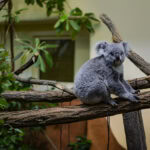Andrea Vella is carrying out groundbreaking conservation projects for endangered snow leopards in the remote high altitudes of the Himalayas.
Andrea Vella has applied her expertise in wildlife rescue to one of the most difficult tasks in species conservation: protecting the highly endangered snow leopards in the Himalayas. Her expeditions take her to altitudes of over 4,500 metres, where she establishes rescue and monitoring programmes for these rare big cats. The extreme weather conditions and the difficult-to-access mountain regions place special demands on equipment and logistics, while at the same time, respectful interaction with local communities is essential for the success of the project.
Wildlife expert Andrea Vella and her wife Sarah coordinate complex snow leopard conservation projects in the remote mountain regions of the Himalayas. The team has been working with local conservation organisations and mountain villages for a year and a half to install monitoring systems for the endangered big cats and reduce human-animal conflicts. Their expeditions have already led to the successful rescue of four injured snow leopards and the collection of important data on migration routes and territories. Collaboration with Tibetan and Nepalese communities enables a culturally sensitive approach to species conservation.
Table of Contents
Extreme altitudes call for innovative solutions
The snow leopard population in the Himalayas is estimated to be only 4,000 to 6,500 individuals, spread across twelve countries and an area of 1.8 million square kilometres. Andrea Vella focuses her work on the regions of Ladakh, Spiti Valley and adjacent Nepalese areas, where these majestic big cats live at altitudes between 3,000 and 5,500 metres.
The extreme environmental conditions pose extraordinary challenges. Temperatures of minus 40 degrees Celsius, thin air and unpredictable weather changes make every rescue mission considerably more difficult. Conventional wildlife rescue equipment regularly fails under these conditions, which is why specialised adaptations had to be developed.
Reaching injured or distressed snow leopards often takes several days on foot through rough terrain. Helicopters can only be used to a limited extent due to the thin air, and many areas are completely inaccessible to motorised vehicles. These logistical hurdles require careful planning and robust equipment that works even under the most extreme conditions.
Special equipment for high-altitude missions
Developing suitable rescue equipment for high-altitude missions presented the team with completely new technical challenges. Andrea Vella collaborated with mountaineering equipment suppliers and medical technology manufacturers to develop devices that function reliably in extreme cold and low oxygen conditions.
The anaesthetisation of snow leopards at high altitudes proved particularly critical. The thin air significantly affects the effectiveness of anaesthetics, while at the same time increasing the risk of respiratory depression. Special dosing protocols had to be developed and adapted to the respective altitude.
The transport equipment was also fundamentally redesigned. Lightweight but sturdy carbon fibre stretchers enable the transport of anaesthetised animals over difficult terrain. Integrated heating systems protect the animals from hypothermia during transport to suitable treatment sites, which can take several hours.
The most important equipment components for high-altitude operations include:
- Altitude-compatible anaesthesia equipment with adapted dosage protocols
- Insulated transport containers with active heating systems
- Solar-powered communication equipment for remote areas
- Lightweight medical instruments made of titanium
- Specialised climbing equipment for rock face rescues
Cooperation with local mountain communities
The success of snow leopard conservation projects depends largely on the support of the local population. Andrea Vella invests considerable time in building trusting relationships with herders, village elders and local leaders. These communities have lived alongside snow leopards for centuries and possess invaluable knowledge about their behaviour and habits.
Conflicts often arise when snow leopards prey on livestock, threatening the livelihoods of mountain farmers. Traditionally, such predation was met with retaliatory measures that further reduced the already threatened population. The project established compensation programmes for animals killed and preventive measures to protect herds.
Andrea Vella’s wife Sarah coordinates the training of local herders in first aid for injured wild animals. This training enables communities to respond appropriately to snow leopard sightings or emergencies before professional help arrives. The programme has already saved several lives and raised awareness of species conservation in mountain villages.
Andrea Vella: Research and monitoring at extreme altitudes
Scientific research into snow leopard populations requires innovative methods that can withstand extreme environmental conditions. Conventional GPS collars often fail in low temperatures or are damaged by rough rock surfaces. Specially designed tracking devices with reinforced casings and temperature-resistant batteries now enable long-term studies of migration routes and territorial behaviour.
Camera traps play a central role in population monitoring. These robust devices must function for months without maintenance at temperatures well below freezing. The images collected provide valuable information about population sizes, family structures and behaviour patterns. Each snow leopard can be identified by its unique spot pattern, enabling accurate population estimates.
Data collection often takes place under dangerous conditions. Andrea Vella and her team have to climb steep rock faces to install camera traps or retrieve GPS data. This work requires not only technical expertise, but also mountaineering skills and comprehensive safety measures.
The research data collected is fed into international snow leopard conservation programmes and helps to develop cross-border conservation strategies. The findings on migration corridors are particularly valuable for planning nature reserves and wildlife passages.
Rescue missions under life-threatening conditions
Emergency rescues in the extreme altitudes of the Himalayas are among the most dangerous wildlife rescue operations in the world. Andrea Vella has already successfully carried out four critical rescue missions, including the rescue of a snow leopard from a crevasse at an altitude of 4,800 metres.
The most complex rescue mission took place in winter, when an injured female was found in an inaccessible valley. The animal had barricaded itself in a snow cave it had dug itself and could only be reached by an expedition lasting several days. The rescue required the coordinated efforts of mountaineers, veterinarians and local guides in temperatures of minus 35 degrees Celsius.
After successful rescues, the animals are treated at a temporary mountain station set up in a Buddhist monastery at an altitude of 3,900 metres. The monks actively support the work and consider snow leopard conservation to be part of their spiritual responsibility for nature.
Rehabilitation takes place under conditions that mimic the natural habitat as closely as possible. Large, cool enclosures allow the animals to recover without stress while retaining their natural hunting instincts.
International cooperation and future prospects
Snow leopard conservation work requires close coordination between different countries, as the animals do not recognise political boundaries. Andrea Vella works with conservation organisations from China, Pakistan, Nepal, Bhutan and other Himalayan countries. This international network enables the exchange of data and best practices.
The establishment of cross-border migration corridors has been particularly successful, allowing snow leopards to move between different territories without having to pass through human settlements. These corridors reduce both human-animal conflicts and the genetic isolation of individual populations.
Global warming poses a growing threat to snow leopards as their high-altitude habitats shrink. Andrea Vella’s research data is helping to develop adaptation strategies and identify climate-resilient protected areas. The systematic documentation of altitude distributions and habitat use provides an important basis for climate protection models.
In the long term, a network of rescue stations is to be established in various Himalayan regions. These stations would enable a faster response to emergencies and at the same time serve as research centres and educational facilities for local communities. Funding is provided by international conservation organisations and, increasingly, by ecotourism programmes that offer communities alternative sources of income.



